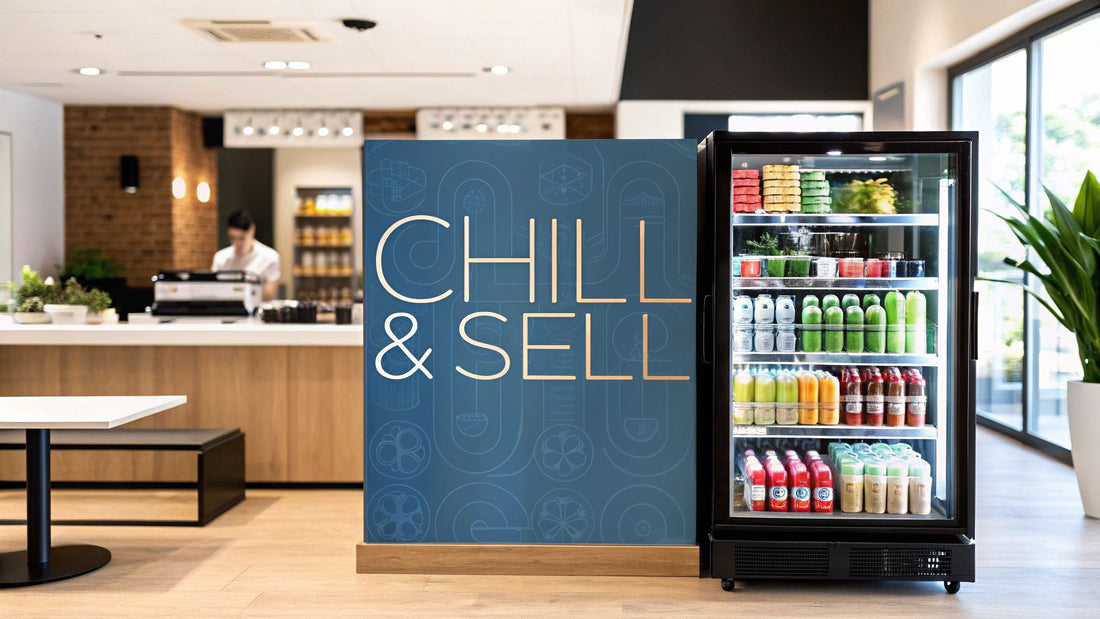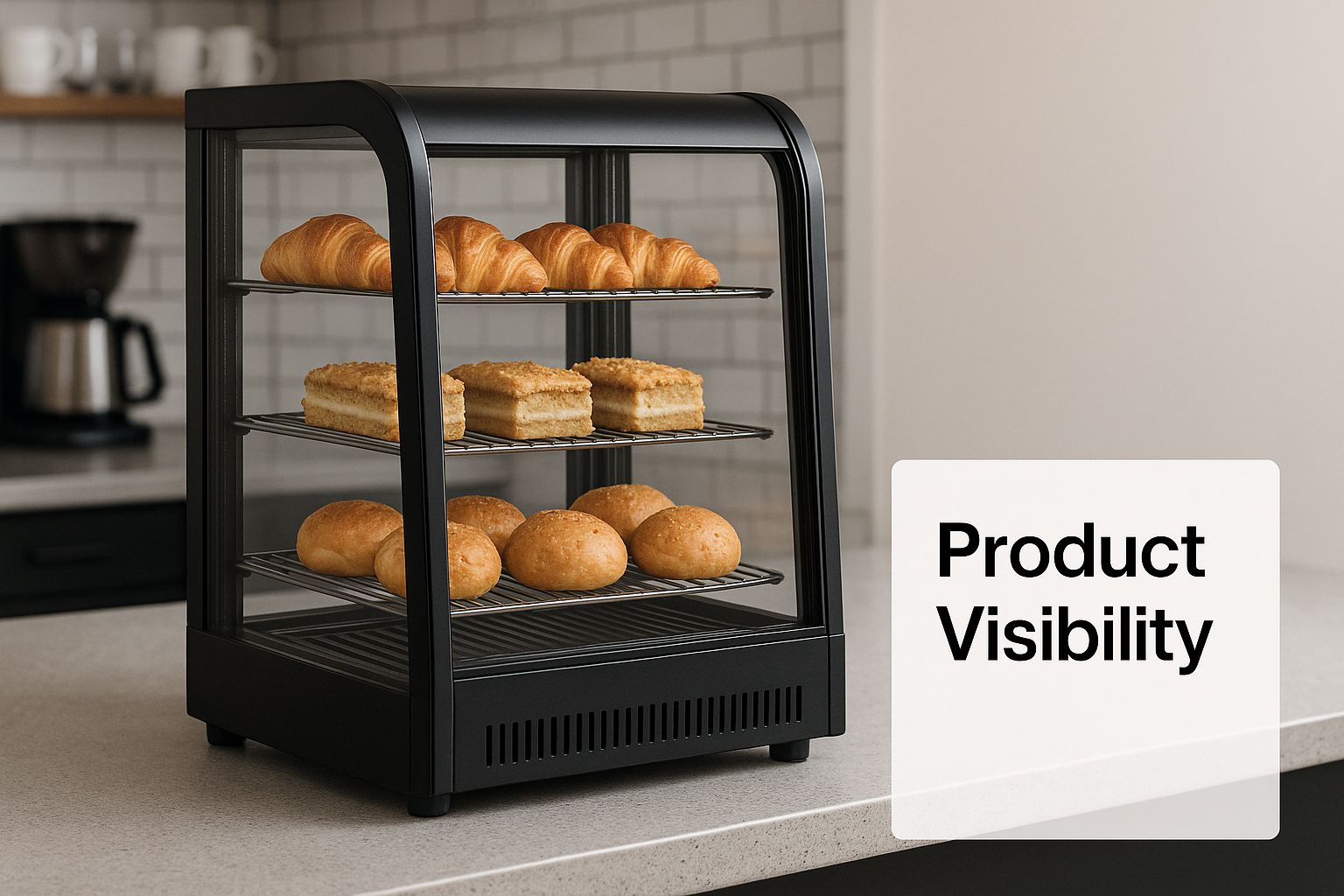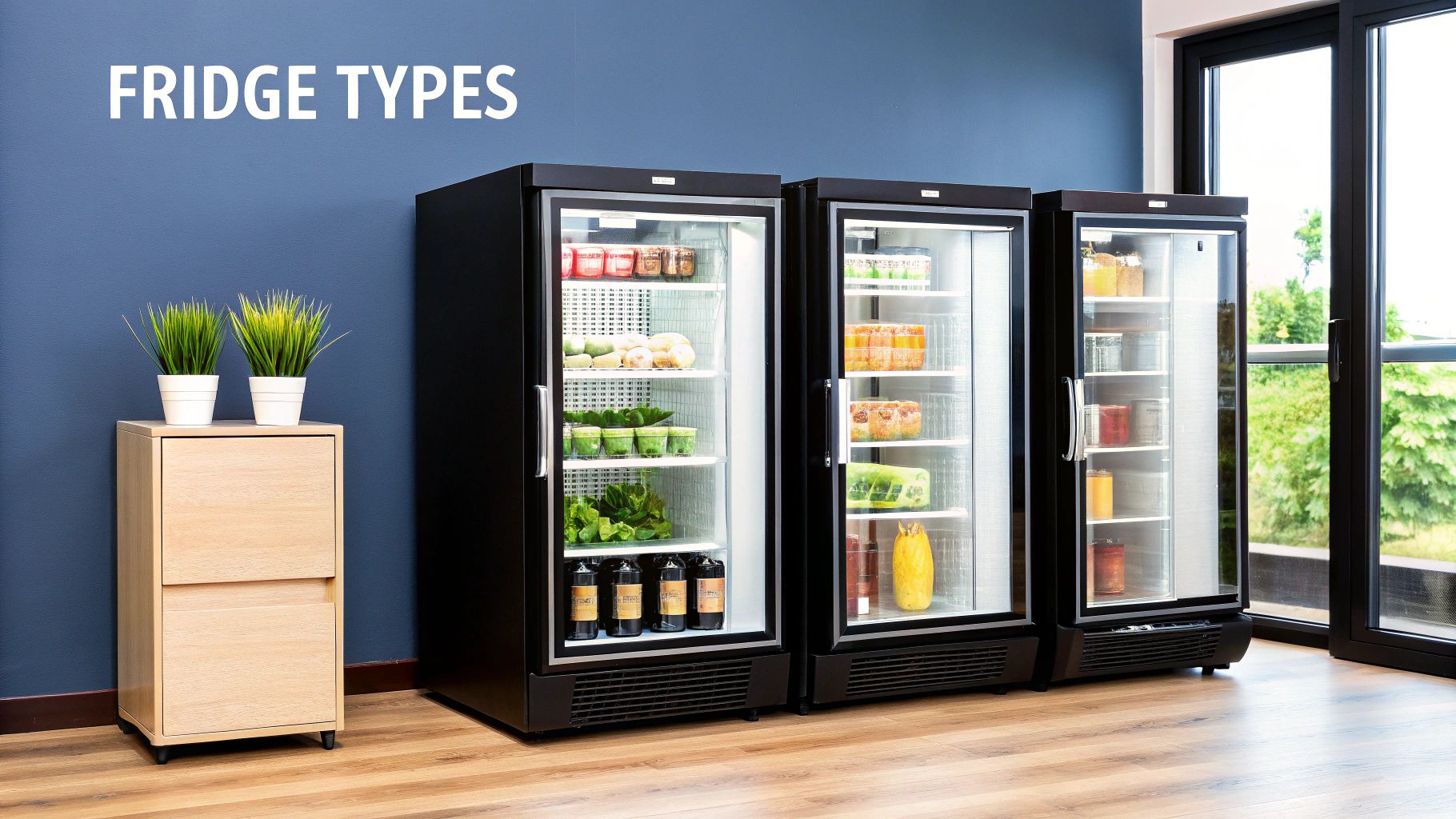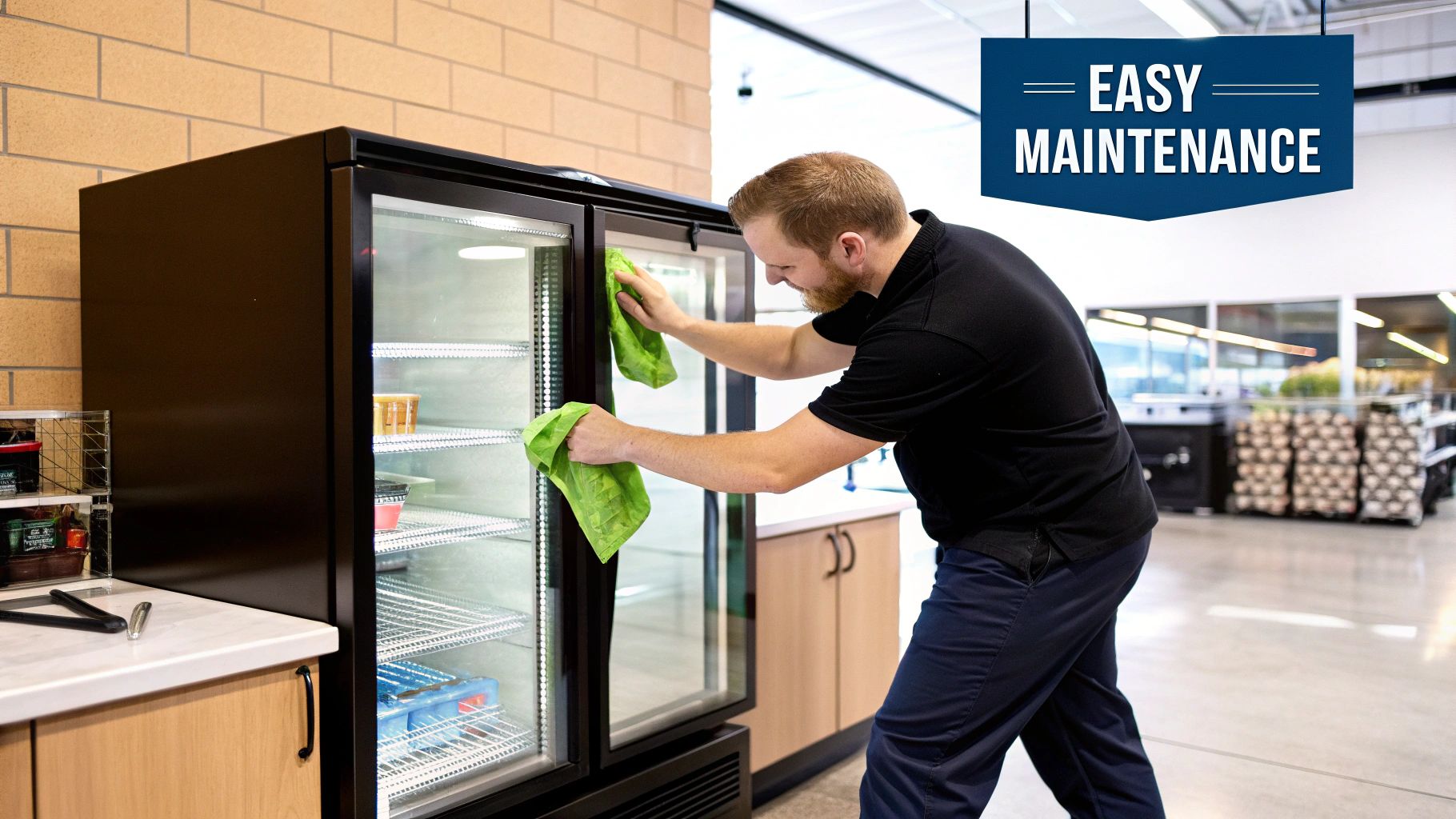
Your Guide to Countertop Display Refrigerators
Share
What if your countertop could do more than just hold a cash register? Imagine it actively selling your most profitable items, all on its own. That's exactly what a countertop display refrigerator does. It’s a compact, powerful merchandiser that works as your silent salesperson.
These units are specifically designed to catch your customer's eye and turn a quick glance into a last-minute purchase, showcasing high-margin drinks, desserts, and grab-and-go snacks right at the point of sale. For restaurant owners and chefs, staying informed about equipment trends like these is key to maximizing revenue.
Turn Your Counter Into a Profit Center
Think of your checkout counter as the most valuable real estate in your shop. It’s the one place every single customer has to stop, giving you a final, golden opportunity to bump up their total order. A strategically placed display of ice-cold sodas or rich, decadent desserts can effortlessly turn a standard transaction into a more profitable one. This is where a countertop display refrigerator really shines.
Unlike the big, bulky refrigerators hidden away in your kitchen, these displays are built for showmanship. They use bright, appealing lighting and crystal-clear glass to make your best products pop, tapping directly into the power of impulse buys. A customer might not have walked in planning to buy a slice of cheesecake, but seeing it perfectly chilled and beautifully presented can be almost impossible to resist. This is a crucial industry trend that successful operators are leveraging.
The Growing Demand for Visual Merchandising
This isn't just a hunch; the market numbers back it up. The global countertop display refrigerator market was valued at around USD 1.23 billion in 2024 and is expected to climb to USD 1.85 billion by 2033. This surge is fueled by a growing understanding in restaurants, cafés, and convenience stores that what customers see, they buy.
This compact equipment doesn’t just keep your products fresh; it makes them look fantastic and easy for customers to grab. That simple convenience improves their experience and, more importantly, your bottom line. Because they can fit in just about any high-traffic spot, these units are a seriously smart investment for any food service business.
By placing your most appealing products right at eye level, you aren't just storing them—you're actively marketing them. This simple change in approach can have a huge impact on your daily revenue, no extra staff required.
To get the most out of your new display, it helps to think about the bigger picture of customer engagement. You can explore proven strategies to boost in-store sales that will work hand-in-hand with your new equipment.
What to Look For in a Commercial Display Unit
Choosing the right countertop display refrigerator isn't just about buying another piece of equipment; it's a smart play that can directly boost your sales and protect your reputation for quality. Think of it as the prime real estate on your counter—a brightly lit "storefront window" for your most tempting grab-and-go items. To get it right, you need to look past the price and focus on the features that will actually make you money.
A true commercial display unit is built to withstand the chaos of a busy café or shop. Unlike a home fridge, it has a beefy compressor designed to recover its temperature quickly after the door has been opened for the tenth time in five minutes. That constant, reliable chill is the bedrock of food safety and product quality.
As you can see below, getting a clear view of the products is what makes these units so effective.

When a customer can clearly see a delicious slice of cake or a refreshing iced tea, the sale practically makes itself.
Essential Features for Maximum Impact
When you start comparing different models, a few features are absolute must-haves for any serious food business. These aren't just bells and whistles; they work together to make your products look great while protecting your bottom line. Smart chefs and owners know that industry trends point towards equipment that is both functional and efficient.
A great way to understand what matters is to break down the key features and see how they translate into real-world benefits for your business.
Key Features and Their Impact on Your Business
| Feature | What It Is | Why It Matters for Your Restaurant |
|---|---|---|
| Double-Paned, Anti-Fog Glass | Two layers of glass with an insulating air gap and a special coating to prevent condensation. | This is huge. It keeps the cold air locked inside, saving you money on your energy bill. The anti-fog layer means your products are always visible, which is critical for encouraging impulse buys, especially in a humid kitchen. |
| Bright LED Lighting | Modern, energy-efficient lighting that illuminates the interior without generating heat. | You want your food to pop. Cool-running LED lights make your sandwiches, drinks, and desserts look irresistible. Plus, they don't add heat that could spoil food or make the compressor work overtime. |
| Adjustable Shelving | Interior shelves that can be moved up or down to different heights. | Your menu isn't static, so your display shouldn't be either. This gives you the flexibility to show off tall drink bottles one day and wide platters of pastries the next. Coated wire shelves are a plus, as they let cold air circulate freely. |
| Digital Thermostat | An external digital display that shows the precise internal temperature. | This is a non-negotiable for food safety. It lets you and your team check the temperature with a quick glance, ensuring you’re always compliant with health codes and protecting your inventory from spoilage. |
These features combine to create a unit that doesn't just store food but actively helps you sell it.
Functionality That Keeps Up With Your Business
Beyond the core components, think about how the unit will fit into your daily workflow.
A display unit's value isn't just in what it holds, but in how it presents it. The right combination of visibility, lighting, and flexibility can turn a passive storage unit into an active sales tool.
That's why adjustable shelving is so important. You need to be able to reconfigure the space on the fly to accommodate new menu items or seasonal specials. Coated wire shelves are often the best bet, as they promote even air circulation and prevent "warm spots" that can compromise food safety.
Finally, a precise digital thermostat with an external display is your best friend. It gives you immediate, easy-to-read proof that your products are being held at a safe temperature. This level of control is no longer a luxury—it's a necessity.
In fact, the demand for reliable units like these is booming. The refrigerated display cases market was valued at USD 9.02 billion in 2025 and is projected to climb to USD 13.34 billion by 2029. This growth is largely driven by a greater focus on food safety from both businesses and consumers. You can read the full research about these market trends to get a deeper sense of where the industry is heading.
Finding the Right Countertop Display Fridge for Your Business
Picking out a countertop display refrigerator isn't something you can just do on a whim. The perfect model for a café showing off delicate pastries will be all wrong for a pizza joint trying to move ice-cold drinks. It's a lot like hiring for a key position in your kitchen—you need the right fit for the specific job if you want to see the best results.
Your first move? Grab a tape measure. Seriously. Before you even start looking at different models, you need to know exactly what you're working with. Measure the height, width, and depth of the counter space you have available. It’s a classic mistake to fall in love with a unit that's too big, which only leads to a logistical nightmare or a frustrating return. Make sure you leave a few inches of breathing room on all sides for ventilation.

Getting this simple step right from the start ensures your new piece of equipment will slide right into your workflow, not throw a wrench in it.
Footprint vs. Capacity: Getting the Balance Right
Once you've got your dimensions locked in, it's time to think about capacity, which is usually measured in cubic feet. This isn’t just about how much stuff you can cram in there, but how much you need to hold to keep up with your customers. A smaller footprint is obviously great for saving space, but you have to match the internal volume to your sales pace.
Think about what you're selling to find your sweet spot:
- High-Volume Drinks: If you're slinging dozens of bottled sodas and juices every day, you need enough capacity to get you through a rush without constantly running to the back for restocks.
- Artisanal Desserts: Got a few gorgeous, high-end cakes or pies? A smaller, more elegant unit might be the better choice. It can even create a sense of exclusivity and draw the eye right where you want it.
- Grab-and-Go Sandwiches: If you're displaying pre-made sandwiches or salads, pay close attention to the shelf depth. You need to make sure your platters or containers fit without getting squished. For more tips on setting up your sandwich line, check out our guide to refrigerated sandwich prep tables.
Front-Breathing or Rear-Breathing? It Matters More Than You Think
Here's a technical detail that has a huge impact on where you can actually put your new fridge: the ventilation system. The compressor has to breathe to get rid of heat, and the way it's designed will limit your placement options.
- Rear-Breathing: These are the most common and are often easier on the wallet. They need a good amount of clearance—usually 4-6 inches—at the back and on the sides to work properly.
- Front-Breathing: These models pull air in and push it out from the front vent. This is a brilliant design because it lets you install the unit flush against a wall or even build it into a counter. You get a ton more flexibility, but they typically cost a bit more.
A front-breathing model can be an absolute game-changer for a tight kitchen. It opens up counter space you'd never be able to use for refrigeration otherwise.
Don't Overlook Energy Efficiency
Your countertop display fridge is going to be running 24/7, which means it will be a constant presence on your utility bill. Spending a little more upfront for an energy-efficient model can genuinely pay for itself over time with lower electricity costs. Keep an eye out for ENERGY STAR certified units; they’re independently verified to use less power, so you know you're getting a performer.
This isn't just about saving a few bucks, either. The entire commercial refrigeration market—valued at around USD 15 billion in 2025 and projected to hit USD 23 billion by 2033—is moving toward more sustainable and cost-effective equipment. By choosing an efficient model, you're not just making a smart financial decision; you're aligning your business with where the industry is heading.
Merchandising Strategies That Boost Impulse Buys
So, you've got a great countertop display refrigerator. That's a solid start, but how you use it is what really moves the needle on sales. Stop thinking of it as just a cold box; it's a tiny, powerful storefront window right on your counter. With a bit of strategic thinking, you can turn a simple transaction point into an impulse-buy machine.
The most valuable real estate you have is right next to the cash register or at the front of a pickup line. No question. These are high-traffic zones where you have a captive audience for at least a few moments. Placing your display unit here is a classic move because it works. A beautifully lit, perfectly chilled treat becomes an almost irresistible last-minute grab.
Arranging Products for Maximum Appeal
Once you’ve nailed down the location, what you do inside the case makes all the difference. The goal is to create a display that’s not just organized, but also visually stunning. You want to guide the customer's eye right to the items you want them to buy most.
Here are a few tried-and-true techniques:
- Best-Sellers Go at Eye Level: The middle shelves are your money-makers. This is where you put your most popular drinks or highest-margin desserts. It’s the first place people look, so make it count.
- Group by Color or Type: Create clean, satisfying visual blocks. Put all the green juices together, line up the colorful fruit tarts, or dedicate a section to chocolatey goodness. It looks sharp and makes it easy for customers to spot what they’re craving.
- Let There Be Light: Good lighting is non-negotiable. Modern LEDs make colors pop and give everything a fresh, vibrant look. Make sure the light is bright and even, so there are no shadowy corners where products go to be forgotten.
An effective display is never static. Regularly rotating your products, introducing seasonal specials, and keeping the unit impeccably clean and fully stocked signals quality and freshness to your customers.
Keeping Your Display Fresh and Full
Nothing kills an impulse buy faster than a sad, half-empty display. It looks picked-over and unappealing.
Make it a daily habit for your team to restock the unit, wipe down the glass until it sparkles, and pull every item forward. A consistently full and vibrant display creates a feeling of abundance and makes everything inside look way more desirable.
These tactics are just one piece of a bigger puzzle in creating a great customer experience. For a deeper dive into visual strategy, check out these innovative retail display ideas to get more inspiration. And if you're still exploring your options, our guide on choosing the right food case display can help you nail the fundamentals.
At the end of the day, pairing a great piece of equipment with smart merchandising is how you unlock its true profit-boosting power.
Essential Maintenance to Protect Your Investment
Your countertop display refrigerator is one of the hardest-working pieces of equipment you own. It runs 24/7, keeping your products perfectly chilled while tempting customers to make that impulse buy. Just like any other critical tool in your business, it needs regular care to keep doing its job well. If you neglect it, you're looking at poor cooling, climbing energy bills, and eventually, an expensive breakdown that could cost you hundreds in spoiled inventory.
Think of routine maintenance as cheap insurance for your investment. A few simple habits can add years to your unit's lifespan, guarantee food safety, and keep it looking sharp for your customers. It all starts the moment you get it out of the box.

Proper Setup and Installation
Believe it or not, your maintenance plan starts with installation. Getting the setup right from day one is the foundation for efficient, long-lasting performance and helps prevent unnecessary strain on the compressor—the heart of the machine.
Before you even think about plugging it in, pick the right spot. The unit needs to sit on a level, sturdy surface, and you absolutely must keep it away from heat sources like ovens, fryers, or even a window that gets direct sun. Why? Because external heat forces the compressor to work overtime just to keep things cool inside.
Most importantly, give it some breathing room.
Manufacturers typically recommend leaving at least 2-4 inches of clear space around the back and sides. This space is crucial for ventilation. Without proper airflow, the compressor can easily overheat, run inefficiently, and burn out way sooner than it should.
A Simple Cleaning and Maintenance Schedule
The easiest way to keep your unit in top shape is to build these small tasks right into your team's regular cleaning routines. A consistent schedule is what turns a potential disaster into a minor to-do list item. If you want to build a more comprehensive plan for all your gear, this guide on commercial kitchen equipment maintenance is a great place to start.
Here's a simple schedule that breaks it all down.
Preventative Maintenance Checklist
This schedule helps ensure your countertop display unit runs efficiently and lasts for years.
| Frequency | Task | Benefit |
|---|---|---|
| Daily | Wipe down glass doors, handles, and exterior surfaces. Clean any interior spills immediately. | Maintains a professional appearance and prevents sticky buildup and odors. |
| Weekly | Inspect rubber door gaskets for any cracks or tears. Wipe them down with a damp cloth. | A good seal keeps cold air in, reducing energy costs and compressor strain. |
| Monthly | Clean the condenser coils. Unplug the unit and use a stiff brush or vacuum to remove dust and grease. | This is the single most important task. Clogged coils are the #1 cause of compressor failure. |
By making these tasks a regular part of your operations, you're actively preventing the most common (and costly) equipment failures.
Quick Troubleshooting for Common Issues
Even a perfectly maintained unit can have an off day. Before you call for a technician, a few quick checks can often solve the problem and save you the cost of a service call.
- Excess Condensation: Seeing fog or water on the glass? First, check that the door is sealing properly all the way around. A worn-out gasket is a common culprit. High humidity in your kitchen can also be a factor, so improving general ventilation might help.
- Temperature Fluctuations: If the fridge isn't staying cold, the first place to look is the condenser coil—is it caked with dust? If the coils are clean, peek inside. Make sure your products aren't packed so tightly that they're blocking the internal air vents.
- Unit Not Running: Don't panic. Start with the basics. Is it plugged in all the way? Did someone trip a circuit breaker? It's often the simplest things that are overlooked.
Frequently Asked Questions
When you're equipping a commercial kitchen, you're bound to have questions. Getting the right answers about your countertop display refrigerator is key to protecting your investment, keeping food safe, and boosting sales. Let's walk through some of the most common questions we get from chefs and business owners just like you.
What's the Ideal Temperature for My Display?
For most pre-packaged foods and drinks, you'll want to keep things between 35°F and 40°F (1.6°C to 4.4°C). That’s the sweet spot. It keeps everything safely chilled and perfectly refreshing for your customers, without ever getting close to freezing.
Of course, there are exceptions. If you're showing off delicate items like pastries or specific desserts, you might lean closer to the 40°F mark to keep their texture just right. Your first stop should always be the manufacturer's guide for your specific model. A great pro-tip? Keep a separate, calibrated thermometer inside the unit. It’s a simple way to double-check that your display is holding the correct temperature and staying compliant with food safety rules.
Can I Just Use a Residential Mini-Fridge in My Restaurant?
I hear this one a lot, and the answer is always a hard no. Trying to use a residential mini-fridge in a commercial setting is a mistake that can cause some serious headaches down the road. Commercial-grade units are built tough, with powerful compressors designed to handle the constant door openings of a busy shop. They recover their temperature in a flash, which is non-negotiable for food safety.
A residential fridge simply can't keep up. It will struggle to maintain a safe temperature under the stress of a commercial environment, leading to spoiled product and equipment failure. More importantly, commercial units are NSF-certified, which is a requirement for most health departments. Using a non-certified fridge can get you flagged on an inspection.
How Much Breathing Room Does My Unit Need?
Giving your refrigerator enough space isn't just a friendly suggestion—it’s absolutely vital for its lifespan and performance. The compressor works hard, and it generates heat. It needs good airflow to get rid of that heat, or it will start to overwork, burn more energy, and eventually burn out.
As a general rule, plan for at least 2 to 4 inches of clear space around the back and sides. But don't guess! The exact amount of space depends on whether your model is front-breathing or rear-breathing. Before you settle on a permanent spot for it, always pull out the unit's spec sheet and make sure you're giving it the room it needs to breathe properly.
How Can I Stop Condensation From Fogging Up the Glass?
A foggy, dripping glass door is the last thing you want customers to see. It makes your products look unappealing and hides them from view. Condensation usually boils down to two things: high humidity in your space or a bad door seal.
First, check the rubber gasket around the door. Is it clean? Is it creating a tight seal all the way around when you close it? Even a small gap can let warm, humid air seep in. For a long-term fix, modern commercial units with double-paned or heated glass and an anti-fog coating are a game-changer. If your current model doesn't have these features, focus on controlling the ambient humidity in your room and try not to place the unit directly in the line of an AC vent.
Ready to turn your counter into a profit center? At Encore Seattle Restaurant Equipment, we help restaurant owners and chefs discover the latest industry trends and exclusive deals on top-quality supplies. We have a huge selection of reliable units to fit any space and budget. Check out our collection of commercial refrigeration and find the perfect countertop display refrigerator to make your best products shine.
